
Space Shuttle Enterprise |
Space Shuttle Enterprise OV-101 was used for five test flights of the last phases of the approach to landing at Edwards Air Force Base from August 12, 1977 to October 26, 1977. It was often displayed at the Edwards Air Force Base open house in the early 1980s. It is now on display at the Intrepid Museum, New York City.
The Enterprise was carried aloft on the back of former American Airlines 747-123 N905NA and released to glide to a landing on Rogers Dry Lake. N905NA first flew on October 15, 1970. Its construction number is 20107. It was delivered to American Airlines as N9668 on October 29, 1970. Boeing had modified the structure of the 747 to support the weight of the space shuttle mounted on its back. The shuttle was attached to three massive struts with explosive bolts.
The flight test series began with five "captive-passive" flights in early 1977. The Enterprise was unoccupied as Fitzhugh Fulton, Tom McMurtry, and flight engineers Vic Horton and Skip Guidry in the 747 Shuttle Carrier Aircraft (747-SCA) evaluated the handling of the piggyback stack. Three "captive-active" flights were performed in the Spring of 1977. A pair of test pilots occupied the Enterprise and operated its flight controls. Sensors in the three struts that supported the space shuttle measured its response to the control imputs.
Five Approach and Landing Test (ALT) glide flights were conducted in the summer and fall of 1977. The 747-SCA lifted the Enterprise 20,000 feet above the Mojave Desert. The JT9D engines of the carrier had been modified to permit operation at more than 100% throttle for a few minutes to increase the launch altitude. Fitzhugh Fulton throttled back and nosed the 747-SCA over into a shallow dive. The Enterprise was mounted with its nose angled upward 7 degrees to increase the lift generated by its wings. As the 747-SCA dived, the Enterprise was actually pulling upward on the mounting struts. When the explosive bolts fired, it was like the shuttle dropped the 747.
A pair of two-pilot teams alternated flights. Fred Haise and Gordon Fullerton flew the first, third, and fifth flights. Joe Engle and Richard Truly flew the second and fourth flights.
The first three flights were flown with the streamlined tailcone in place to reduce the rate of descent of the Enterprise. The 20,000-foot descent to Rogers Dry Lake took about four minutes. The final two glide flights were flown in the orbital configuration, with a set of simulated main engine nozzles in place of the tailcone. The rate of descent on the final two missions approached 10,000 feet per second, and the Enterprise landed just two minutes after release from the 747-SCA.
The first Approach and Landing Test was flown on August 12, 1977. It was the first of three glide flights that Enterprise made with the streamlined tailcone installed. Fred Haise and Gordon Fullerton piloted the shuttle on a four minute flight.
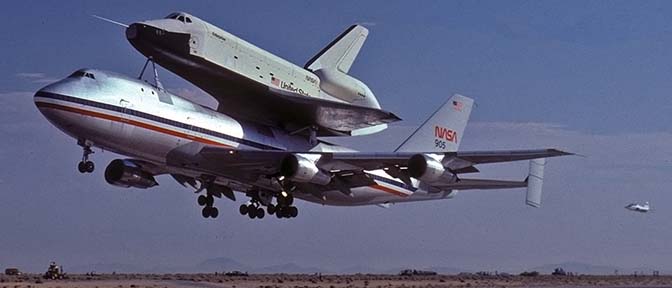 Boeing 747-SCA N905NA takes off from Runway 22 with Enterprise at the beginning of the first Approach and Landing Test (ALT-1) at 8:00 A.M. on August 12, 1977. The American Airlines heritage of the 747-SCA was still apparent. Its Boeing construction number is 20107. It made its first flight on October 15, 1970 and was delivered to American Airlines as 747-123, N9668 two weeks later. NASA acquired it on July 18, 1974. Before modifying it to carry space shuttles, NASA used it in a series of wake vortex tests to evaluate the dangers of small airplanes flying close behind jumbo jets. N905NA flies under the call sign NASA Nine Oh Five.
Boeing 747-SCA N905NA takes off from Runway 22 with Enterprise at the beginning of the first Approach and Landing Test (ALT-1) at 8:00 A.M. on August 12, 1977. The American Airlines heritage of the 747-SCA was still apparent. Its Boeing construction number is 20107. It made its first flight on October 15, 1970 and was delivered to American Airlines as 747-123, N9668 two weeks later. NASA acquired it on July 18, 1974. Before modifying it to carry space shuttles, NASA used it in a series of wake vortex tests to evaluate the dangers of small airplanes flying close behind jumbo jets. N905NA flies under the call sign NASA Nine Oh Five.
You can buy framed prints or greeting cards of this photograph.
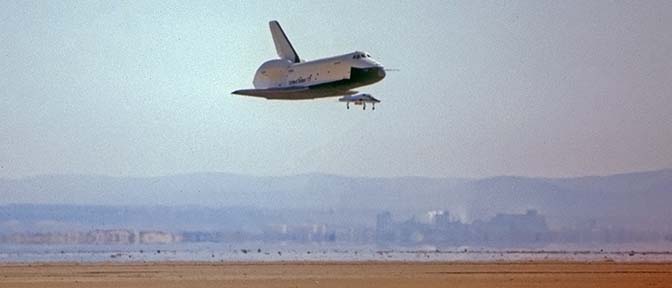 Fred Haise triggered the release of Enterprise from the 747-SCA at 8:48 A.M. The launch occurred east of Rogers Dry Lake as the 747-SCA was flying north. Haise performed a pull-up to evaluate the response of the shuttle at low speed and then pitched over into a dive. He commanded a 180-degree turn to the left to line up with the lakebed runway.
Fred Haise triggered the release of Enterprise from the 747-SCA at 8:48 A.M. The launch occurred east of Rogers Dry Lake as the 747-SCA was flying north. Haise performed a pull-up to evaluate the response of the shuttle at low speed and then pitched over into a dive. He commanded a 180-degree turn to the left to line up with the lakebed runway.
 The landing gear was lowered just seconds before landing. Rocket engine test stands can be seen on Lehmann Ridge in the background.
The landing gear was lowered just seconds before landing. Rocket engine test stands can be seen on Lehmann Ridge in the background.
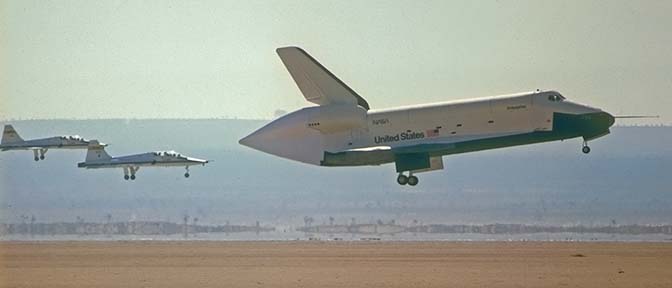 Five of NASA's Northrop T-38A Talons accompanied the 747-SCA and Enterprise on the test flight.
Five of NASA's Northrop T-38A Talons accompanied the 747-SCA and Enterprise on the test flight.
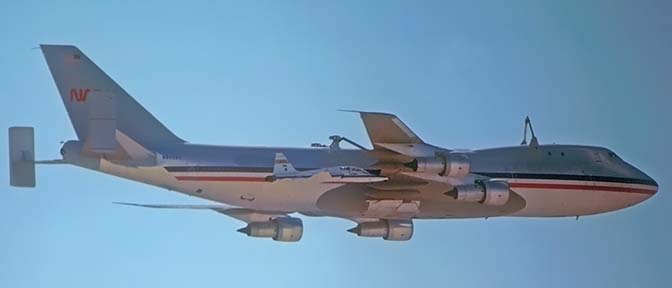 The 747-SCA and a T-38A Talon chase plane made a pass over Enterprise on the lakebed shortly after the test flight.
The 747-SCA and a T-38A Talon chase plane made a pass over Enterprise on the lakebed shortly after the test flight.
 Enterprise was towed very slowly across Rogers Dry Lake to the Mate-Demate Device at NASA Dryden Flight Research Center.
Enterprise was towed very slowly across Rogers Dry Lake to the Mate-Demate Device at NASA Dryden Flight Research Center.
 Scaffolding was quickly moved into place around the 747-SCA after the flight.
Scaffolding was quickly moved into place around the 747-SCA after the flight.
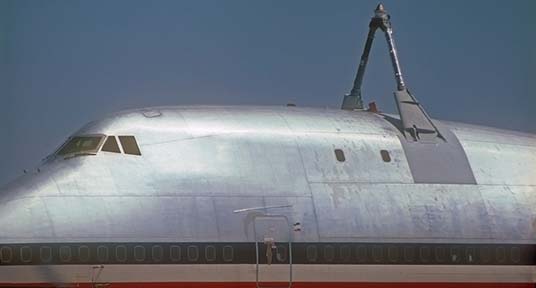 Detail shot of the forward mounting struts reveals one blue mission symbol representing the five captive-passive flights and one red symbol representing the three captive-active flights behind the door just above the blue stripe.
Detail shot of the forward mounting struts reveals one blue mission symbol representing the five captive-passive flights and one red symbol representing the three captive-active flights behind the door just above the blue stripe.
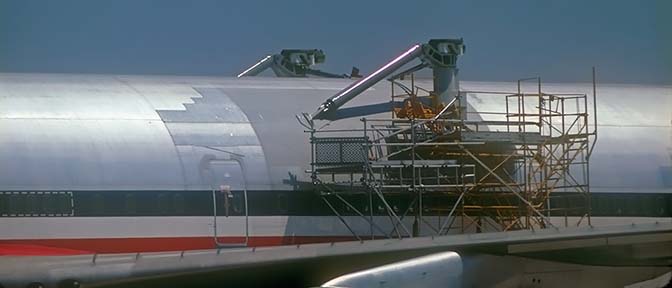 Detail shot of the rear mounting struts.
Detail shot of the rear mounting struts.
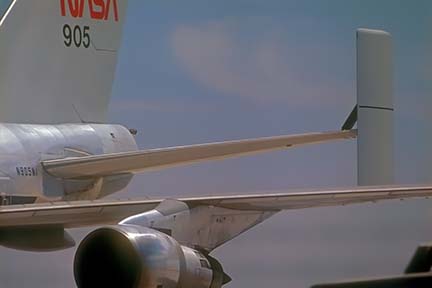 Detail of the modifications to the horizontal stabilizer. Extra vertical stabilizers were add to the end of the horizontal stabilizer to compensate for the loss of directional stability resulting from the turbulent airflow around the vertical stabilizer behind the shuttle.
Detail of the modifications to the horizontal stabilizer. Extra vertical stabilizers were add to the end of the horizontal stabilizer to compensate for the loss of directional stability resulting from the turbulent airflow around the vertical stabilizer behind the shuttle.
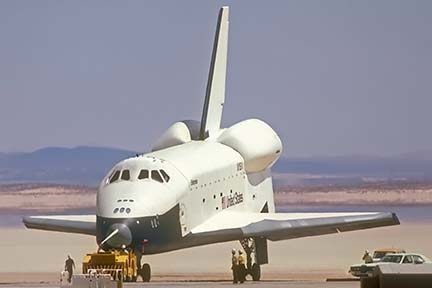 Enterprise nears the end of its long, slow journey across the lakebed.
Enterprise nears the end of its long, slow journey across the lakebed.
 Enterprise framed by the the Mate-Demate Device.
Enterprise framed by the the Mate-Demate Device.
 Enterprise is towed into the Mate/Demate Device.
Enterprise is towed into the Mate/Demate Device.
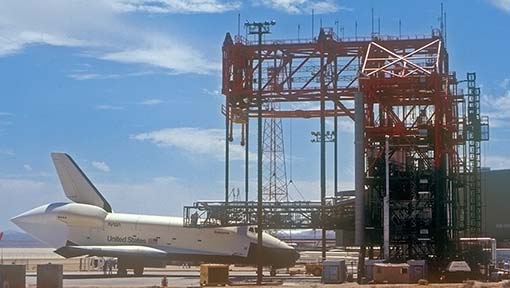 The Mate-Demate Device incorporates a yellow crane to lift the space shuttle and a gray work platform that can be raised and lowered for access to the shuttle on the ground or while mounted on the 747-SCA.
The Mate-Demate Device incorporates a yellow crane to lift the space shuttle and a gray work platform that can be raised and lowered for access to the shuttle on the ground or while mounted on the 747-SCA.
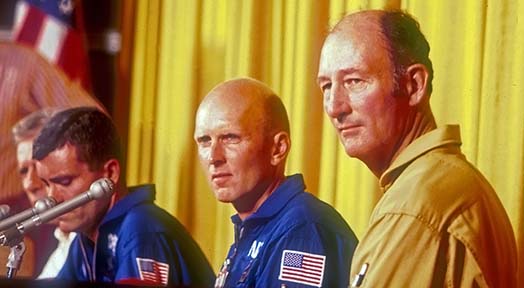 NASA pilots Gordon Fullerton and Fitzhugh Fulton. Fulton piloted all of the flights of the 747-SCA during the evaluation of Enterprise.
NASA pilots Gordon Fullerton and Fitzhugh Fulton. Fulton piloted all of the flights of the 747-SCA during the evaluation of Enterprise.
 Deke Slayton, Fred Haise and Gordon Fullerton. Slayton, at left, was the head of the Shuttle Approach and Landing Test Program. He was one of the original seven Mercury astronauts, but a heart condition kept him grounded until the Apollo-Soyuz Test Project in 1975.
Deke Slayton, Fred Haise and Gordon Fullerton. Slayton, at left, was the head of the Shuttle Approach and Landing Test Program. He was one of the original seven Mercury astronauts, but a heart condition kept him grounded until the Apollo-Soyuz Test Project in 1975.
The fourth Approach and Landing Test was flown on October 12, 1977. It was the first of two glide flights that the Enterprise made without the streamlined tailcone. Joe Engle and Richard Truly piloted the Enterprise on a two-minute descent of 20,000 feet. This time the shuttle was launched to the north of the lakebed. and it flew a straight in approach that lasted just two minutes.
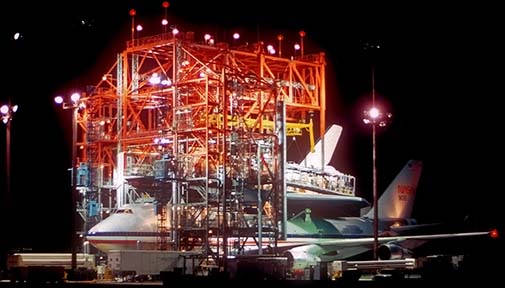 Enterprise and the 747-SCA sit in the Mate-Demate Device in the pre-dawn darkness on October 12.
Enterprise and the 747-SCA sit in the Mate-Demate Device in the pre-dawn darkness on October 12.
 The planet Venus shined brightly in the night sky over the Mate-Demate Device as the orange dawn began to light up the east.
The planet Venus shined brightly in the night sky over the Mate-Demate Device as the orange dawn began to light up the east.
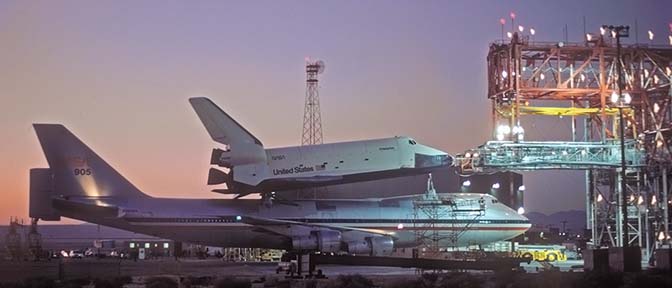 The 747-SCA and Enterprise are pushed back from the Mate-Demate Device.
The 747-SCA and Enterprise are pushed back from the Mate-Demate Device.
You can buy framed prints or greeting cards of this photograph.
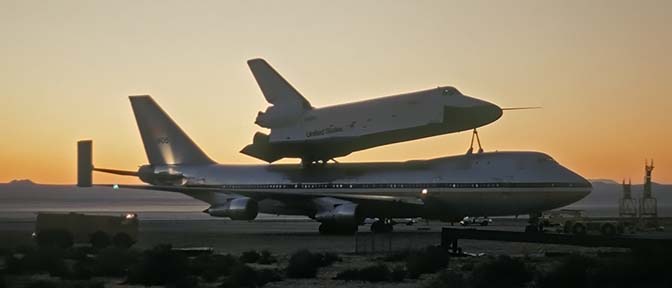 Enterprise is silhouetted against the orange dawn as the 747-SCA is pushed to the engine start-up area.
Enterprise is silhouetted against the orange dawn as the 747-SCA is pushed to the engine start-up area.
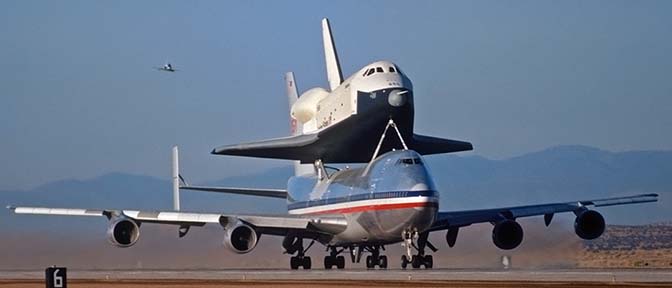 One of a pair of NASA Northrop T-38A Talon chase planes can be seen approaching on the far side of the 747-SCA as it begins its take-off roll. The chase planes assumed position on each side of the piggyback stack as it lifted off the ground.
One of a pair of NASA Northrop T-38A Talon chase planes can be seen approaching on the far side of the 747-SCA as it begins its take-off roll. The chase planes assumed position on each side of the piggyback stack as it lifted off the ground.
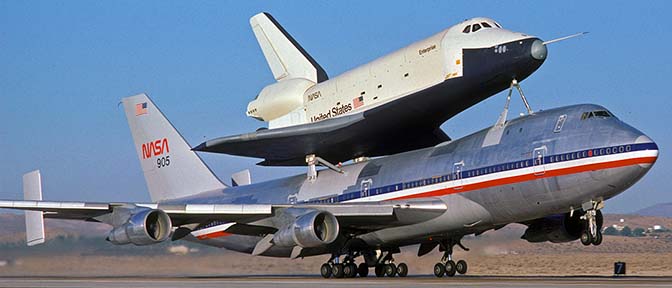 747-SCA, N905NA takes off from Runway 04 with Enterprise. Runway 04 was used for this flight because it leads onto Rogers Dry Lake. If the new configuration of Enterprise caused any unexpected problems after take-off, the piggyback stack could be landed straight ahead on the lakebed.
747-SCA, N905NA takes off from Runway 04 with Enterprise. Runway 04 was used for this flight because it leads onto Rogers Dry Lake. If the new configuration of Enterprise caused any unexpected problems after take-off, the piggyback stack could be landed straight ahead on the lakebed.
You can buy framed prints or greeting cards of this photograph.
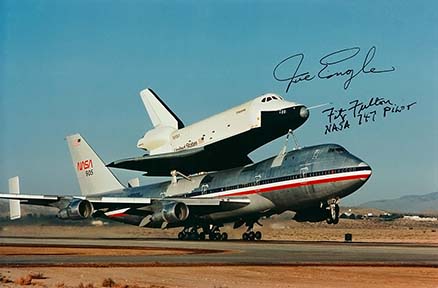 Photo autogrqaphed by Joe Engle, commander of the Enterprise and Fitzhugh Fulton, pilot of the 747-SCA.
Photo autogrqaphed by Joe Engle, commander of the Enterprise and Fitzhugh Fulton, pilot of the 747-SCA.
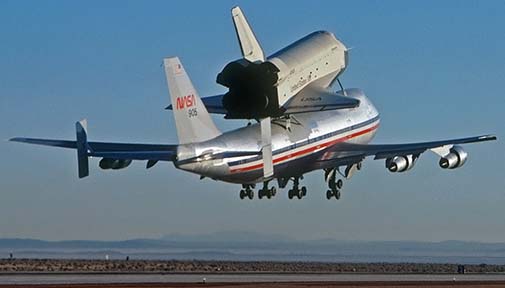 The landing gear of the 747-SCA remained extended as it climbed away from Runway 04 in order to facilitate an emergency landing on Rogers Dry Lake if buffeting or vibration threatened the flight.
The landing gear of the 747-SCA remained extended as it climbed away from Runway 04 in order to facilitate an emergency landing on Rogers Dry Lake if buffeting or vibration threatened the flight.
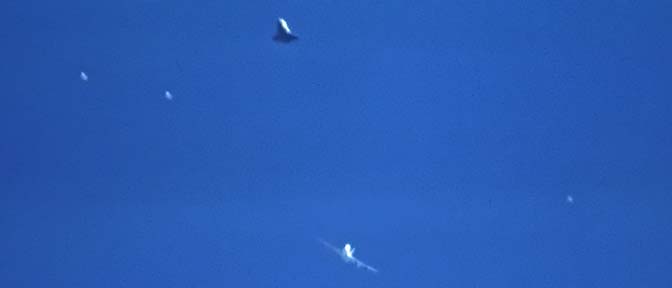 Eight miles away and four miles up, the 747-SCA makes a diving turn to the left shortly after Joe Engle triggered the separation of Enterprise. Two T-38A Talon chase planes can be seen to the left of Enterprise and another Talon can be seen to the right.
Eight miles away and four miles up, the 747-SCA makes a diving turn to the left shortly after Joe Engle triggered the separation of Enterprise. Two T-38A Talon chase planes can be seen to the left of Enterprise and another Talon can be seen to the right.
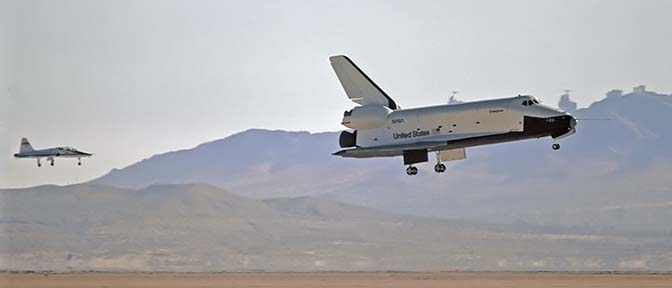 Two minutes later, Enterprise flares for landing.
Two minutes later, Enterprise flares for landing.
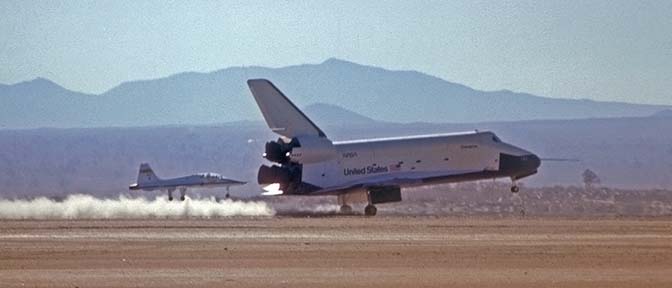 Enterprise kicks up a rooster tail of dust as it touches down on the clay surface of Rogers Dry Lake. The T-38A Talon chase plane did not touch down. It remained airborne as Enterprise rolled to a stop and then returned to the main runway to land.
Enterprise kicks up a rooster tail of dust as it touches down on the clay surface of Rogers Dry Lake. The T-38A Talon chase plane did not touch down. It remained airborne as Enterprise rolled to a stop and then returned to the main runway to land.
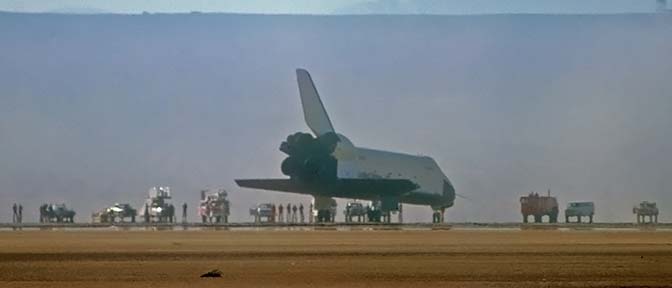 Support vehicles and personell gather around Enterprise on the lakebed.
Support vehicles and personell gather around Enterprise on the lakebed.
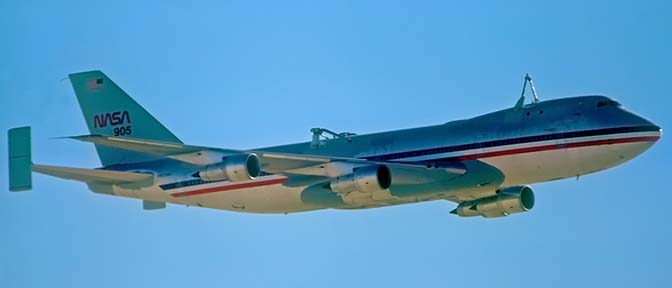 The 747-SCA made the usual flyby after the landing.
The 747-SCA made the usual flyby after the landing.
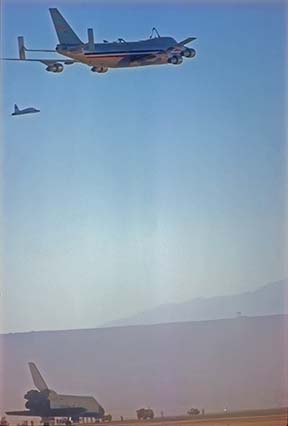 The 747-SCA and a T-38A Talon chase plane pass over Enterprise.
The 747-SCA and a T-38A Talon chase plane pass over Enterprise.
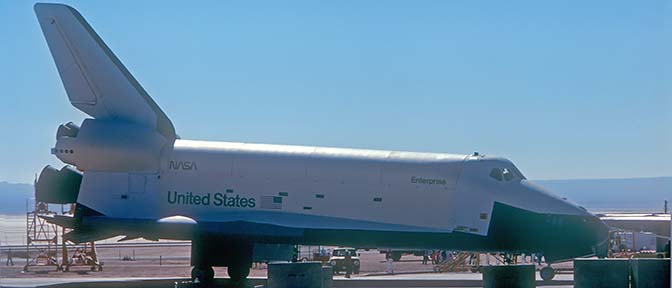 Enterprise is towed back to the Mate-Demate Device.
Enterprise is towed back to the Mate-Demate Device.
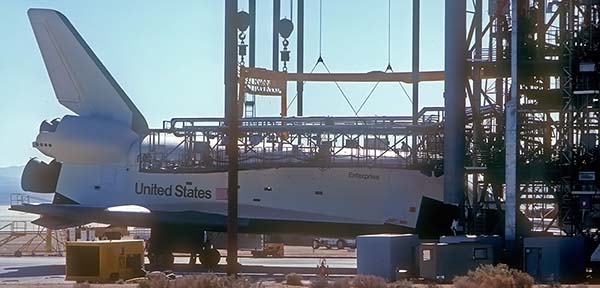 Enterprise takes its place in the Mate-Demate Device to be prepared for the next ALT mission.
Enterprise takes its place in the Mate-Demate Device to be prepared for the next ALT mission.
The fifth and final ALT flight was flown on October 26, 1977. Fred Haise and Gordon Fullerton piloted Enterprise to a landing on concrete Runway 04, encountering a pilot induced oscillation as they flared for landing. The flight control issues revealed during this landing were later investigated with NASA's Fly-by-Wire F-8 Crusader.
Three weeks after the last ALT flight, Enterprise was displayed at the Edwards Air Force Base Open House mounted on the back of the 747-SCA.
 The forward mounting struts on the the 747-SCA were replaced with shorter struts to reduce the drag of the shuttle during the upcoming ferry flight to Huntsville, Alabama.
The forward mounting struts on the the 747-SCA were replaced with shorter struts to reduce the drag of the shuttle during the upcoming ferry flight to Huntsville, Alabama.
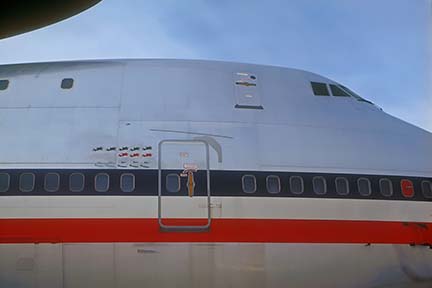 ALT Mission marks were applied on the sides of the fuselage of the 747-SCA. The five dark blue symbols in the top line represent the captive-passive flights. The three red symbols in the second line represent the captiva-active flights. The three blue symbols at right in the bottom line prepresent the first three ALT flights with the tailcone attached. The two light blue symbols at left in the bottom line prepresent the last two ALT flights with the tailcone removed.
ALT Mission marks were applied on the sides of the fuselage of the 747-SCA. The five dark blue symbols in the top line represent the captive-passive flights. The three red symbols in the second line represent the captiva-active flights. The three blue symbols at right in the bottom line prepresent the first three ALT flights with the tailcone attached. The two light blue symbols at left in the bottom line prepresent the last two ALT flights with the tailcone removed.
Following the open house, 747-SCA N905NA carried Enterprise aloft on test flights on November 15, November 16, November 17, November 18, and December 9.
On March 10, 1978, 747-SCA N905NA took off from Edwards Air Force Bdse with Enterprise to deliver it to the Marshall Space Flight Center at Hunstville, Alabama for shaker table tests. The orbiter was mated to an external tank and boosters and mounted on an enormous shaker table. The entire stack was vibrated to determine its response to the shaking that it would endure during a launch.
At the conclusion of the shaker table tests, Enterprise returned to Edwards Air Force Base and was displayed at several Open House events from 1979 to 1983.
 Enterprise was displayed on its multi-wheeled transporter at the Edwards Air Force Base Open House on October 28, 1979.
Enterprise was displayed on its multi-wheeled transporter at the Edwards Air Force Base Open House on October 28, 1979.
 Enterprise was displayed standing on its landing gear at the Edwards Air Force Base Open House on September 20, 1981.
Enterprise was displayed standing on its landing gear at the Edwards Air Force Base Open House on September 20, 1981.
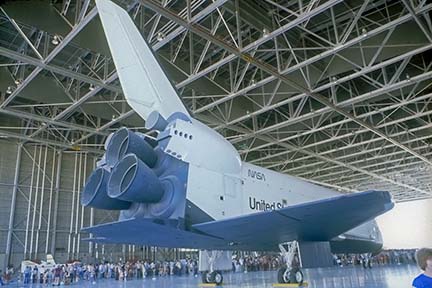 Enterprise' main engine nozzles were non-functional, aerodynamic representations of the actual rocket nozzles.
Enterprise' main engine nozzles were non-functional, aerodynamic representations of the actual rocket nozzles.
 747-SCA N905NA was displayed at the Edwards Air Force Base Open House on September 20, 1981.
747-SCA N905NA was displayed at the Edwards Air Force Base Open House on September 20, 1981.
Columbia, OV-102 landed at Edwards Air Force Base at the conclusion of its fourth mission on July 4, 1982, the same day that Challenger, OV-099 departed Edwards on its way to the Kennedy Space Center for the first time. President Ronald Reagan attended the events. After Columbia's landing, he gave a speech and directed Challenger to take off.
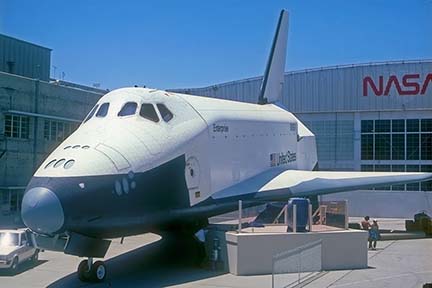 Enterprise served as the backdrop for President Reagan's speech. It is seen here on July 3, before its wings were draped with blue bunting and a multitude of U.S. flags were erected along the roofline. It no longer has its Orbital Maneuvering System (OMS) pods and main engine nozzles.
Enterprise served as the backdrop for President Reagan's speech. It is seen here on July 3, before its wings were draped with blue bunting and a multitude of U.S. flags were erected along the roofline. It no longer has its Orbital Maneuvering System (OMS) pods and main engine nozzles.
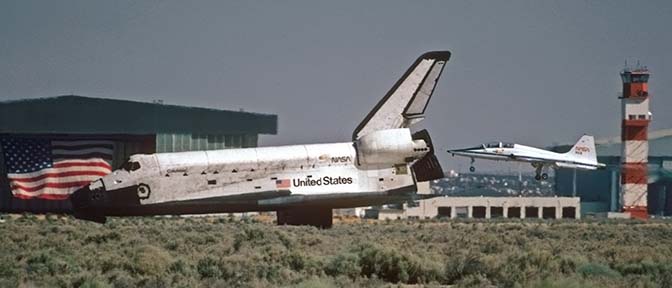 Columbia rolls out after landing on Runway 22 at Edwards AFB on July 4, 1982. President Reagan observed the landing from a position near the giant flag in the hangar door on the other side of the runway. NASA Northrop T-38A Talon, N923NA is still flying at a speed well below the landing speed of the shuttle.
Columbia rolls out after landing on Runway 22 at Edwards AFB on July 4, 1982. President Reagan observed the landing from a position near the giant flag in the hangar door on the other side of the runway. NASA Northrop T-38A Talon, N923NA is still flying at a speed well below the landing speed of the shuttle.
 Challenger
was delivered to NASA from Edwards AFB shortly after Columbia
landed. Columbia sitting on Runway 22 with 747-SCA, N905NA carrying Challenger. This was the first occasion on which two spaceflight capable space shuttles appeared together. I was the only photographer still waiting on the south side of the runway. All the others had gone to see the President's speech. At the moment I took this picture, President Reagan was leading the crowd in a rendition of God Bless America.
Challenger
was delivered to NASA from Edwards AFB shortly after Columbia
landed. Columbia sitting on Runway 22 with 747-SCA, N905NA carrying Challenger. This was the first occasion on which two spaceflight capable space shuttles appeared together. I was the only photographer still waiting on the south side of the runway. All the others had gone to see the President's speech. At the moment I took this picture, President Reagan was leading the crowd in a rendition of God Bless America.
 Enterprise was displayed without its OMS pods and main engine nozzles at the Edwards Air Force Base Open House on October 30, 1983.
Enterprise was displayed without its OMS pods and main engine nozzles at the Edwards Air Force Base Open House on October 30, 1983.
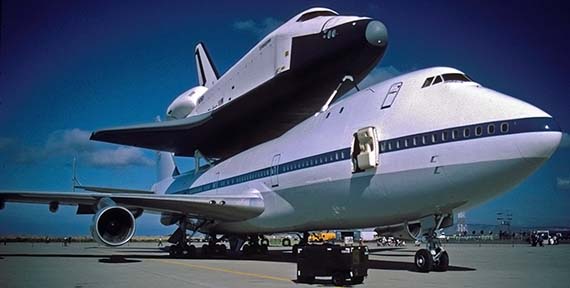 Enterprise was displayed at the Vandenberg Air Force Base Airshow on the back of 747-SCA, N905NA on November 14, 1984. The pair had been displayed at the Paris Airshow at le Bourget Aerodrome in 1983. NASA repainted N905NA white with a blue stripe in preparation for its international debut.
Enterprise was displayed at the Vandenberg Air Force Base Airshow on the back of 747-SCA, N905NA on November 14, 1984. The pair had been displayed at the Paris Airshow at le Bourget Aerodrome in 1983. NASA repainted N905NA white with a blue stripe in preparation for its international debut.
 Enterprise was displayed at the Vandenberg Air Force Base Airshow on the back of 747-SCA N905NA on November 14, 1984. It was later towed to Space Launch Complex 6 (SLC-6) for launch pad fit checks.
Enterprise was displayed at the Vandenberg Air Force Base Airshow on the back of 747-SCA N905NA on November 14, 1984. It was later towed to Space Launch Complex 6 (SLC-6) for launch pad fit checks.
Enterprise is now the centerpiece of the James S. McDonnell Space Hangar at the National Air and Space Museum's Steven F. Udvar-Hazy Center in Chantilly, Virginia.
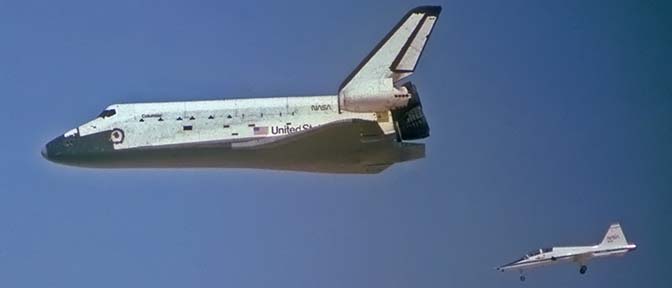 More pictures from Space Shuttle events.
More pictures from Space Shuttle events.
You can buy a 2020 calendar featuring my photographs of Space Shuttle Carrier Aircraft.
A dozen photos of 747 Shuttle Carrier Aircraft. Events depicted include:
747-SCA N905NA/Enterprise Approach and Landing Test 1 take-off on August 12, 1977.
747-SCA N905NA/Enterprise Approach and Landing Test 4 take-off on October 12, 1977.
747-SCA N905NA/Columbia delivery take-off on March 20, 1979.
747-SCA N905NA/Challenger static and departure take-off on July 4, 1982.
747-SCA N911NA/Endeavor delivery take-off from Palmdale on May 2, 1991.
747-SCA N905NA/Columbia landing at Palmdale on September 25, 1999.
747-SCA N905NA/Discovery take-off on November 2, 2000.
747-SCA N905NA/Atlantis take-off on July 1, 2007.
747-SCA N911NA/Endeavor take-off on December 10, 2008.
747-SCA N911NA/Discovery take-off on September 20, 2009.
747-SCA N905NA/Endeavor flyover at LAX, September 21, 2012.
 Put a copy of the Shuttle Carrier Aircraft 2020 calendar in your Lulu.com shopping cart for $14.95.
Put a copy of the Shuttle Carrier Aircraft 2020 calendar in your Lulu.com shopping cart for $14.95.
You can buy a 2020 calendar featuring my photographs of Space Shuttle Endeavour at Edwards Air Force Base.
Bad weather caused the Space shuttle Endeavour to divert to Edwards Air Force Base at the conclusion of STS-126 on November 30, 2007. Following servicing in the Mate/Demate Device, it departed from Edwards on the back of 747 Carrier Aircraft N911NA on December 10.
 Put a copy of the Space Shuttle Endeavour at Edwards Air Force Base: 2020 calendar in your Lulu.com shopping cart for $14.95.
Put a copy of the Space Shuttle Endeavour at Edwards Air Force Base: 2020 calendar in your Lulu.com shopping cart for $14.95.
You can buy a 2020 calendar featuring my photographs of Space Shuttle Discovery at Edwards Air Force Base.
A dozen photographs of the Space Shuttle Discovery at Edwards Air Force Base. Bad weather at the Kennedy Space Center caused the Space shuttle Discovery to divert to Edwards Air Force Base at the conclusion of mission STS-128 on September 11, 2009. Following servicing in the Mate/Demate Device, it departed from Edwards on the back of 747 Carrier Aircraft N911NA on September 20.
 Put a copy of the Space Shuttle Discovery at Edwards Air Force Base: 2020 calendar in your Lulu.com shopping cart for $14.95.
Put a copy of the Space Shuttle Discovery at Edwards Air Force Base: 2020 calendar in your Lulu.com shopping cart for $14.95.
You can buy a 2020 calendar featuring my photographs of Space Shuttle Endeavour's Final Flights.
A dozen photos of Space Shuttle Endeavour's Final Flights. Boeing 747-Shuttle Carrier Aircraft N905NA and Space Shuttle Endeavour arrived at Edwards Air Force Base from Biggs Army Airfield on September 20, 2012. The pair were placed on static display at the NASA Dryden Flight Research Center that afternoon. The 747/Shuttle stack departed from Edwards Air Force Base on the morning of September 21. It toured California and several landmarks in the LA Basin. It made two low passes over Los Angeles International Airport before making its final landing. The 747-SCA was flown to Edwards Air Force Base on September 24 where it was retired. The Endeavour ison display at the California Science Center.
 Put a copy of the Space Shuttle Endeavour's Final Flights 2020 calendar in your Lulu.com shopping cart for $14.95.
Put a copy of the Space Shuttle Endeavour's Final Flights 2020 calendar in your Lulu.com shopping cart for $14.95.
Books and Videos about the Space Shuttle from Amazon.com |
||||||
Books |
||||||
DVDs |
||||||
Visit the Lockett Books Amazon Webstore for a selection of aviation and space related books and DVDs. |
||||||
 Go to the Airshow
Page of the Goleta Air and Space Museum.
Go to the Airshow
Page of the Goleta Air and Space Museum.
Send a message to Brian.